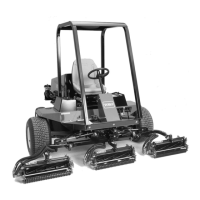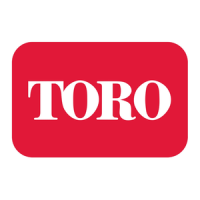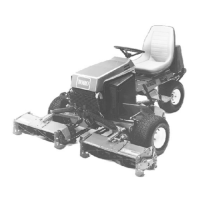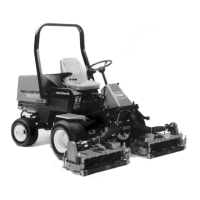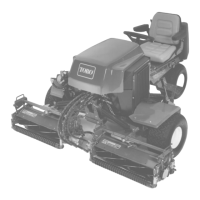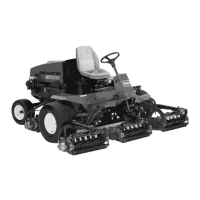– Do not dri v e close to sand traps , ditc hes ,
creeks , or other hazards .
– R educe speed when making shar p tur ns .
A v oid sudden stops and star ts .
– W hen near or crossing roads , alw a ys yield
the right-of-w a y .
– Apply the ser vice brak es when g oing
do wnhill to k ee p forw ard speed slo w and
to maintain control of the mac hine .
• T he g rass bask ets m ust be in place during
operation of the cylinders/reels or thatc hers
for maxim um safety . Shut the engine off
before emptying the bask ets .
• Raise the cutting units when dri ving from one
w ork area to another .
• Do not touc h the engine , silencer/m uffler , or
exhaust pipe while the engine is r unning or
soon after it has stopped because these areas
could be hot enough to cause bur ns .
• Sta y clear of the rotating screen at the side of
the engine to prev ent direct contact with y our
body or clothing .
• If the engine stalls or loses headw a y and cannot
mak e it to the top of a slope , do not tur n the
mac hine around. Alw a ys bac k slo wly , straight
do wn the slope .
• W hen a person or pet appears unexpectedly
in or near the mo wing area, stop mo wing .
Careless operation, combined with ter rain
angles , ricoc hets , or improperly positioned
guards can lead to thro wn object injuries . Do
not resume mo wing until the area is cleared.
Maintenance and Storage
• Mak e sure all h y draulic line connectors are
tight and all h y draulic hoses and lines are in
g ood condition before applying pressure to the
system.
• K ee p y our body and hands a w a y from pin hole
leaks or nozzles that eject h y draulic fluid under
high pressure . Use paper or cardboard, not
y our hands , to searc h for leaks . Hy draulic fluid
escaping under pressure can ha v e sufficient
force to penetrate the skin and cause serious
injur y . Seek immediate medical attention if
fluid is injected into skin.
• Before disconnecting or perfor ming any w ork
on the h y draulic system, all pressure in the
system m ust be reliev ed b y stopping the engine
and lo w ering the cutting units and attac hments
to the g round.
• Chec k all fuel lines for tightness and w ear on a
regular basis . Tighten or re pair them as needed.
• If the engine m ust be r unning to perfor m a
maintenance adjustment, k ee p hands , feet,
clothing, and any par ts of the body a w a y from
the cutting units , attac hments , and any mo ving
par ts , especially the screen at the side of the
engine . K ee p ev er y one a w a y .
• T o ensure safety and accuracy , ha v e an
A uthorized T oro Distributor c hec k the
maxim um engine speed with a tac hometer .
Maxim um g o v er ned engine speed should be
2900 RPM.
• If major re pairs are ev er needed or if assistance
is desired, contact an A uthorized T oro
Distributor .
• Use only T oro-appro v ed attac hments and
re placement par ts . T he w ar ranty ma y be
v oided if used with unappro v ed attac hments .
Sound Pressure Level
T his unit has an equi v alent contin uous A-w eighted
sound pressure at the operator ear of: 88 dB(A),
based on measurements of identical mac hines per
EN 11094 and EN 836.
Sound Power Level
T his unit has a guaranteed sound po w er lev el
of: 105 dB A/1 pW , based on measurements of
identical mac hines per EN 11094.
Vibration Level
T his unit does not ex ceed a vibration lev el of 2.5
m/s
2
at the hands based on measurements of
identical mac hines per EN 1033.
T his unit does not ex ceed a vibration lev el of 0.5
m/s
2
at the posterior based on measurements of
identical mac hines per EN 1032.
7
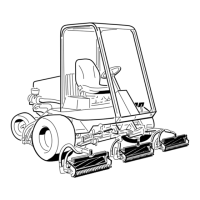
